2. Early Online and Multiplayer Games
3. Recent Online and Multiplayer Games
4. Basic Internet Architecture
5. Network Latency, Jitter and Loss
6. Latency Compensation Techniques
7. Playability versus Network Conditions and Cheats
9. Where Do Players Come from and When?
10. Online Game Traffic Patterns
12. Setting Up Online FPS Game Servers
1. Introduction
2. Early Online and Multiplayer Games
2.1 Defining Networked and Multiplayer Games
2.2 Early Multiplayer Games
2.2.1 PLATO
2.2.2 MultiUser Dungeons
2.2.3 Arcade Games
2.2.4 Hosted Online Games
2.3 Multiplayer Network Games
2.3.1 DOOM-Networked First-Person Shooters Arrive
References
3. Recent Online and Multiplayer Games
3.1 Communication Architectures
3.2 The Evolution of Online Games
3.2.1 FPS Games
3.2.2 Masively Multiplayer Games
3.2.3 RTS Games
3.2.4 Sports Games
3.3 Summary of Growth of Online Games
3.4 The Evolution of Online Game Platforms
3.4.1 PCs
3.4.2 Game Consoles
3.4.3 Handheld Game Consoles
3.4.4 Summary
3.5 Context of Computer Games
3.5.1 Physical Reality
3.5.2 Telepresense
3.5.3 Augmented Reality
3.5.4 Distributed Virtual Environments
References
[DOOMENGINE] http://doom.wikicities.com/wiki/Doom networking engine, Accessed 2006
[PONG] The Pong Story. The Site of the First Video Game. [Online] http://www.pong-story.com/intro.htm
[MOD] David Kushner. Masters of Doom, Random House, 2003. ISBN 1588362892.
[PLATO] Dear, B., PLATO People – A History Book Research Project, http://www.platopeople.com/
[RFC854] Postel, J. and Reynolds, J., “Telnet Protocol Specification”, RFC 854. (May 1983)
4. Basic Internet Architecture
4.1 IP Networks as seen from the Edge
4.1.1 Endpoints and Addressing
4.1.2 Layered Transport Services
4.1.3 Unicast, Broadcast and Multicast
4.2 Connectivity and Routing
4.2.1 Hierarchy and Aggregation
4.2.2 Routing Protocols
4.2.3 Per-hop Packet Transport
4.3 Address Management
4.3.1 Address Delegation and Assignment
4.3.2 Network Address Translation
4.3.3 Dynamic Host Configuration Protocol
4.3.4 Domain Name System
Reference
[BGR+98] S. Benford, C. Greenhalgh, G. Reynard, C. Brown and B. Koleva, “Understanding and constructing shared spaces with mixed-reality boundaries”, ACM Transactions on Computer-Human Interaction (TOCHI), Vol. 5, No. 3, pp. 185–223, 1998.
[BGRP01] S. Benford, C. Greenhalgh, T. Rodden and J. Pycock, “Collaborative virtual environments”, Communications of the ACM, Vol. 44, No. 7, pp. 79–85, 2001.
[BWA96] J.W. Barrus, R.C. Waters and D.B. Anderson, “Locales: supporting large multiuser virtual environments”, IEEE Computer Graphics and Applications, Vol. 16, No. 6, 1996.
[CFG+03] A. David Cheok, S. Wan Fong, K. Hwee Goh, X. Yang, W. Liu and F. Farzbiz, “Human Pacman: A Sensing-based Mobile Entertainment System with Ubiquitous Computing and Tangible Interaction”, Proceedings of ACM Network and System Support for Games Workshop (NetGames), Redwood City, CA, May 2003.
[CNET05] CNET Networks, Inc.,“Playstation3–Xbox 360: Tech Head to Head”, 05/16/2005 [Online] http://hardware.gamespot.com/Story-ST-x-1985-x-x-x
[CSD+92] C. Cruz-Neira, D.J. Sandin, T.A. DeFanti, R. Kenyon and J. Hart, “The CAVE: audio visual experience automatic virtual environment”, Communications of the ACM, Vol. 35, No. 6, pp. 65–72, 1992.
[FS98] E. Freecon and M. Stenius, “DIVE: A scalable network architecture for distributed virtual environments”, Distributed Systems Engineering, Vol. 5, No. 3, pp. 91–100, 1998.
[Ger02] B. Geryk, “A History of Real-Time Strategy Games, Part I: 1989-1998”, Gamespot, 2002,
[Online]http://www.gamespot.com/gamespot/features/all/real time.
[Ken03] S.L. Kent, “Making an MMOG for the Masses”, GameSpy.com, October 10, 2003.
[Kus03] D. Kushner, Masters of Doom, Random House, 2003, ISBN: 0-375-50524-5.
[MADDEN05] Wikipedia,“Madden NFL”, (as of 20 January 2006) [http://en.wikipedia.org/w/index.php?title=Madden NFL&oldid=36020223
[MS94] M.J. Massimino and T.B. Sheridan, “Teleoperator Performance with Varying Force and Visual Feedback”, Journal of Human Factors, Mark Vol. 36, No. 1, pp. 145–157, 1994.
[MSA+94] W. Dean McCarty, S. Sheasby, P. Amburn, M.R. Stytz and C. Switzer, “A Virtual Cockpit for a Distributed Interactive Simulation”, IEEE Computer Graphics and Applications, Vol. 14, No. 1, pp. 49–54, January 1994.
[MSTM04] K. Mansley, D. Scott, A. Tse and A. Madhavapeddy, “Feedback, Latency, Accuracy: Exploiting Tradeoffs in Location-Aware Gaming”, Proceedings of ACM Network and System Support for Games Workshop (NetGames), Portand, OG, 2004.
[NC04] J. Nichols and M. Claypool, “The Effects of Latency on Online Madden NFL Football”, In Proceedings of the 14th ACM International Workshop on Network and Operating Systems Support for Digital Audio and Video (NOSSDAV), Kinsale, County Cork, Ireland, June 16–18, 2004.
[Ney97] D.L. Neyland, “Virtual Combat: A Guide to Distributed Interactive Simulation”, Stackpole Books, Mechanicsburg, PA, 1997.
[PCS+06] L.S. Ping, A.D. Cheok, J.T. Kheng Soon, G.P. Lyn Debra, C.W. Jie, W. Chuang and F. Farzbiz, “A Mobile Pet Wearable Computer and Mixed Reality System for Human – Poultry Interaction through the Internet”, Springer Journal of Personal and Ubiquitous Computing, ISSN: 1617-4909, (Paper) 1617-4917, (Online)03 November, 2005.
[PT02] W. Piekarski and B. Thomas, ARQuake: the outdoor augmented reality gaming system, Communications of the ACM, Vol. 45, No. 1, pp 36–38, 2002.
[QWORLD] Quake World.net, http://www.quakeworld.net/, Accessed 2006.
[SG01] S. Shirmohammadi and N.D. Georganas, “An End-to-end Communication Architecture for Collaborative Virtual Environments”, Computer Networks, Vol. 35, No. 2–3, pp. 351–367, 2001.
[SKH02] J. Smed, T. Kaukoranta and H. Hakonen, Aspects of networking in multiplayer computer games, The Electronic Library, Vol. 20, No. 2, pp. 87–97, 2002.
[Tut04] W. Tuttle, “The Future of Live?”, GameSpy, October 24, 2004, [Online] http://xbox.gamespy.com/articles/559/559846p1.html.
[Tys06] J. Tyson, “How Video Game Systems Work”, HowStuffWorks, Inc, [Online] http://computer.howstuffworks.com/video-game5.htm
[Woo05] B.S. Woodcock. “An Analysis of MMOG Subscription Growth”, MMOGCHART.COM 12.0 29 29 2004. January 1, 2005. Online: http://www.mmogchart.com/.
5. Network Latency, Jitter and Loss
5.1 The Relevance of Latency, Jitter and Loss
5.2 Sources of Latency, Jitter and Loss in the Network
5.2.1 Propagation Delay and the Laws of Physics
5.2.2 Serialisation
5.2.3 Queuing Delays
5.2.4 Sources of Jitter in the Network
5.2.5 Sources of Packet Loss in the Network
5.3 Network Control of Lag, Jitter and Loss
5.3.1 Preferential IP Layer Queuing and Scheduling
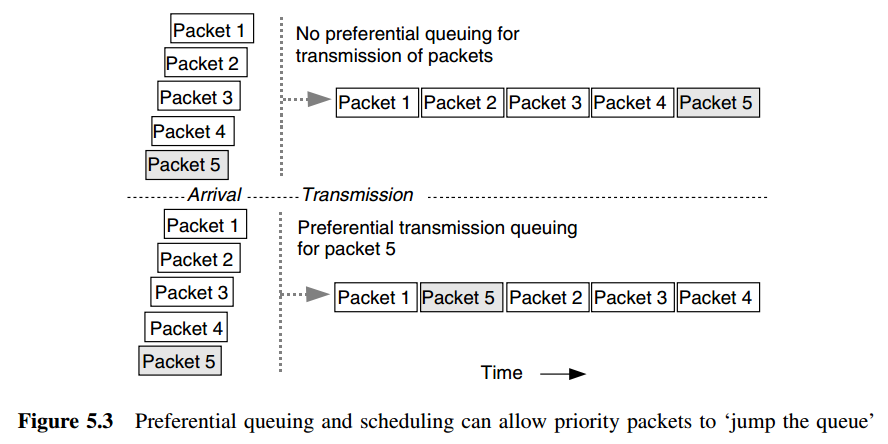
5.3.2 Link Layer Support for Packet Prioritisation
5.3.3 Where to Place and Trust Traffic Classification
5.4 Measuring Network Conditions
References
[ARM2000] G. Armitage, “Quality of Service in IP Networks: Foundations for a Multi-Service Internet”, Macmillan Technical Publishing, April 2000.
[ARM2004] G. Armitage, L. Stewart, “Limitations of using Real-World, Public Servers to Estimate Jitter Tolerance of First Person Shooter Games”, ACM SIGCHI ACE2004 Conference, Singapore, June 2004.
[DOCSIS] CableLabs, “Data-Over-Cable Service Interface Specifications Radio Frequency Interface Specification SP-RFIv1.1-I01-990311”, 1999.
[I311] ITU-T Recommendation I.311, “B-ISDN General Network Aspects”, August 1996.
[NGUYEN04] T.T.T. Nguyen, G. Armitage, “Quantitative Assessment of IP Service Quality in 802.11b Networks and DOCSIS networks”, Australian Telecommunications Networks & Applications Conference 2004, (ATNAC2004), Sydney, Australia, December 8–10, 2004.
[RFC792] J. Postel, “Internet Control Message Protocol”, STD 0005, RFC 792. September 1981.
[RFC1661] W. Simpson Ed, “The Point-to-Point Protocol (PPP)”, STD 51, RFC 1661. July 1994.
[RFC1662] W. Simpson Ed, “PPP in HDLC-like Framing”, STD 51, RFC 1662, July 1994.
[RFC2474] K. Nichols, S. Blake, F. Baker, D. Black. “Definition of the Differentiated Services Field (DS Field) in the IPv4 and IPv6 Headers.” RFC 2474. December 1998.
[RFC2475] S. Blake, D. Black, M. Carlson, E. Davies, Z. Wang, W. Weiss. “An Architecture for Differentiated Services.” RFC 2475. December 1998.
[RFC2309] B. Braden, D. Clark, J. Crowcroft, B. Davie, S. Deering, D. Estrin, S. Floyd, V. Jacobson, G. Minshall, C. Partridge, L. Peterson, K. Ramakrishnan, S. Shenker, J. Wroclawski, L. Zhang, “Recommendations on Queue Management and Congestion Avoidance in the Internet”, RFC 2309. April 1998.
[RFC2686] C. Bormann, “The Multi-Class Extension to Multi-Link PPP”, RFC 2686. September 1999.
[RFC2687] C. Bormann, “PPP in a Real-time Oriented HDLC-like Framing”, RFC 2687. September 1999.
[STE2005] L. Stewart, G. Armitage, P. Branch, S. Zander, “An Architecture for Automated Network Control of QoS over Consumer Broadband Links”, IEEE TENCON 05, Melbourne, Australia, 21–24, November, 2005.
[TR017] ADSL Forum, “TR-017: ATM over ADSL Recommendation”, 1999.
6. Latency Compensation Techniques
6.1 The Need for Latency Compensation
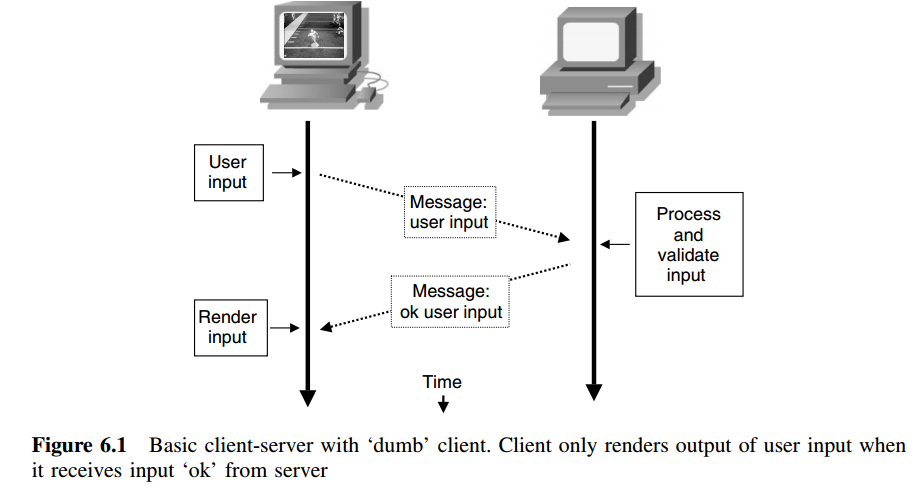
Basic Algorithm (Client Side)
- Sample user input
- Pack up data and send to server
- Receive updates from server and unpack
- Determine visible objects and game state
- Render scene
- Repeat.
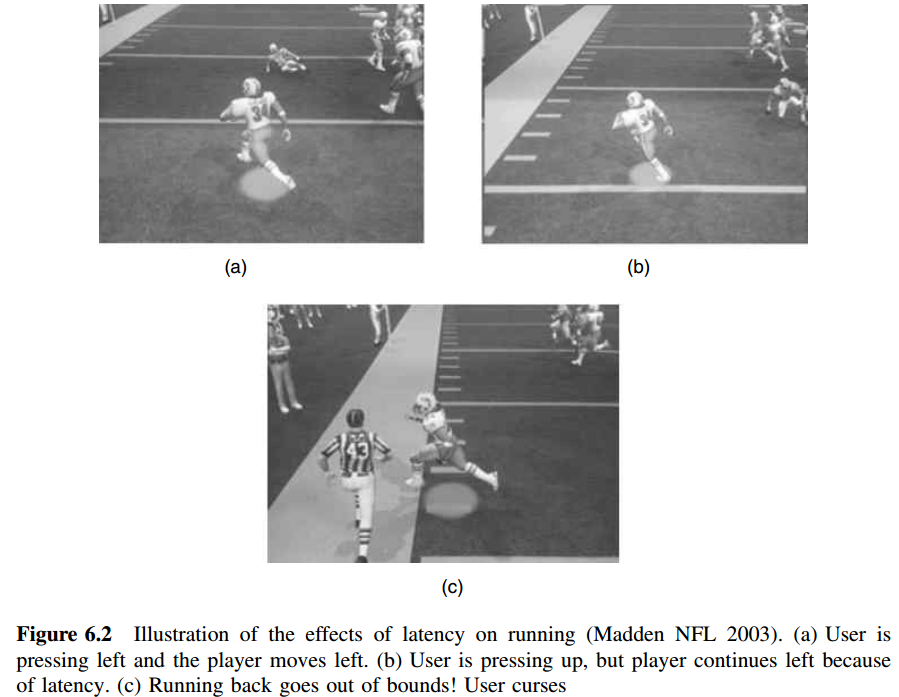
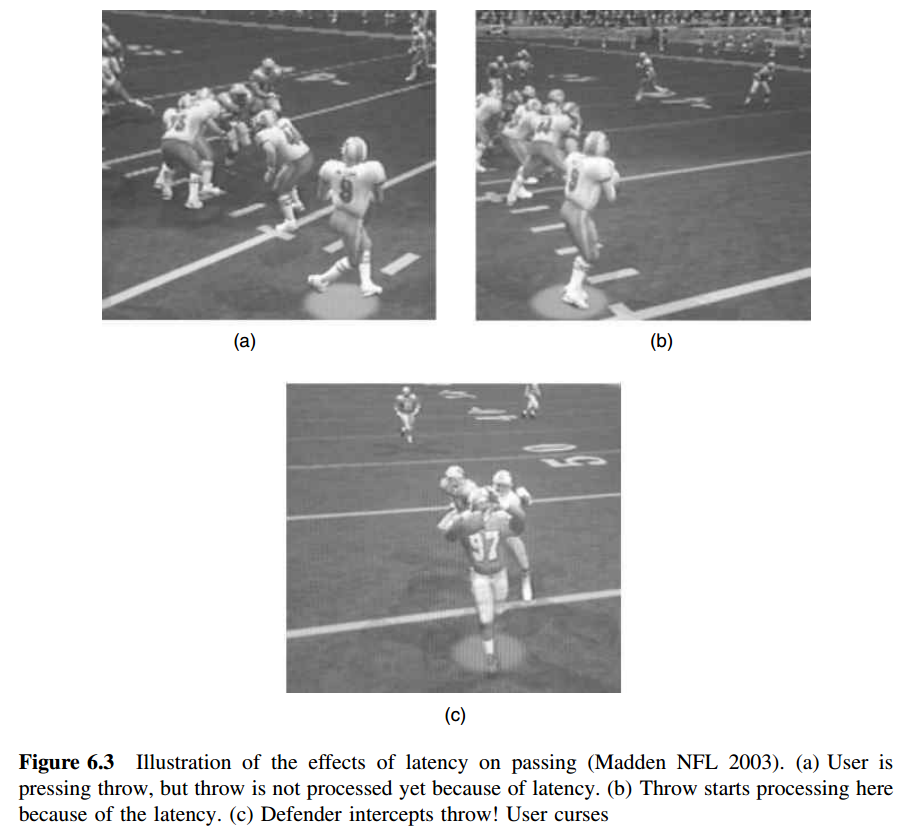
6.2 Prediction
6.2.1 Player Prediction
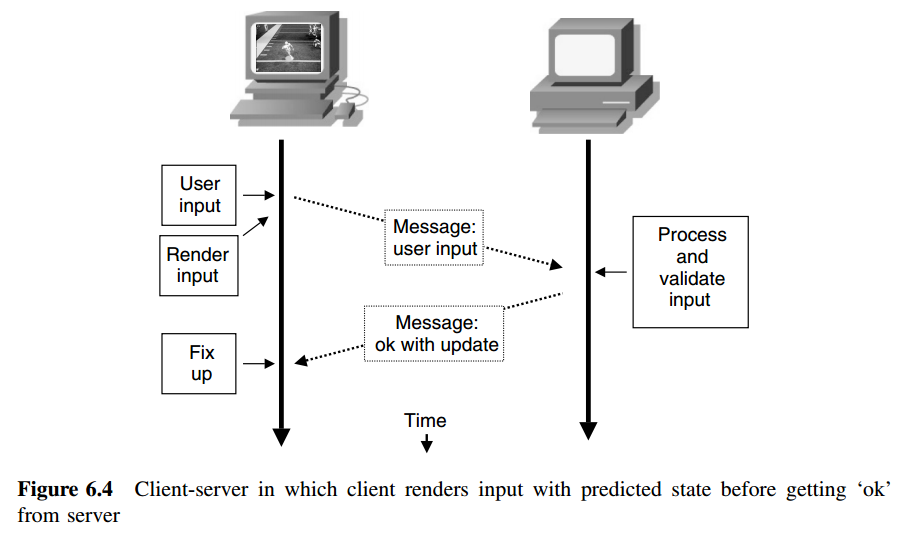
Predicted Algorithm
- Sample user input
- Pack up data and send to server
- Determine visible objects and game state
- Render scene
- Receive updates from server and upack
- Fix up any discrepancies
- Repeat.

6.2.2 Opponent Prediction


6.2.3 Prediction Summary
6.3 Time Manipulation
6.3.1 Time Delay
6.3.2 Time Warp
The general algorithm for the server is as follows:
- Receive packet from client
- Extract information (user input)
- Elapsed time = current time – latency to client
- Rollback all events in reverse order to current time – elapsed time
- Execute user command
- Repeat all events in order, updating any clients affected
- Repeat

6.3.3 Data compression
6.4 Visual Tricks
6.5 Latency Compensation and Cheating
References
[AB05] S. Aggarwal and H. Banavar, “Fairness in Dead-Reckoning Based Distributed Multi-Player Games”, In Proceedings of the 4th ACM Network and System Support for Games (NetGames), Hawthorne, NY, USA, October 2005.
[BGRP01] S. Benford, C. Greenhalgh, T. Rodden, and J. Pycock, “Collaborative virtual environments”, Communications of the ACM, Vol. 44, No. 7, pp. 79–85, 2001.
[CF05] A. Chandler, J. Finney, “On the Effects of Loose Causal Consistency in Mobile Multiplayer Games”, In Proceedings of the 4th ACM Network and System Support for Games (NetGames), Hawthorne, NY, USA, October 2005.
[CLC99] W. Cai, F. Lee, L. Chen, “An Auto-Adaptive Dead Reckoning Algorithm for Distributed Interactive Simulation”, In Proceedings of the 13th ACM Workshop on Parallel and Distributed Simulation, Atlanta, Georgia, USA, Pages: 82–89, 1999.
[Dead reckoning] Wikipedia, “Dead Reckoning”, [Online] http://en.wikipedia.org/wiki/Dead reckoning, Accessed 2006.
[DF98] C. Durbach and J.M. Fourneau, “Performance Evaluation of a Dead Reckoning Mechanism”, Proceedings of the Second International Workshop on Distributed Interactive Simulation and Real-Time Applications, page 23, July 19–20, 1998.
[DIS] Wikipedia, “Distributed Interactive Simulation”, [Online] http://en.wikipedia.org/wiki/Distributed Interactive Simulation, Accessed 2006.
[Mau00] M. Mauve, “How to Keep a Dead Man from Shooting”, Proceedings of the 7th International Workshop on Interactive Distributed Multimedia Systems and Telecommunication Services (IDMS), 2000, pages 199–204, Enschede, Netherlands, October 2000.
[MBD00] K.L. Morse, L. Bic, and M. Dillencourt, “Interest Management in Large-Scale Virtual Environments”, Presence, Vol. 9, No. 1, pp. 52–68, 2000.
[Ney97] D.L. Neyland, “Virtual Combat: A Guide to Distributed Interactive Simulation”, Stackpole Books, Mechanicsburg, PA, 1997.
[Wel84] T.A. Welch, “A Technique for High Performance Data Compression”, IEEE Computer, Vol. 17, No. 6, pp. 8–19, 1984.
[Valve] Valve Developer Community, “Source Multiplayer Networking”, [Online] http://developer.valvesoftware.com/wiki/Source Multiplayer Networking, Accessed 2006.
7. Playability versus Network Conditions and Cheats
7.1 Measuring Player Tolerance for Network Disruptions
7.1.1 Empirical Research
7.1.2 Sources of Error and Uncertainty
7.1.3 Considerations for Creating Artificial Network Conditions
7.2 Communication Models, Cheats and Cheat-Mitigation
7.2.1 Classifying and Naming Methods of Cheating
7.2.2 Server-side Cheats
7.2.3 Client-side Cheats
7.2.4 Network-layer Cheats
7.2.5 Cheat-mitigation
References
[ARM2001] G. Armitage, “Sensitivity of Quake3 Players To Network Latency”, Poster session, SIGCOMM Internet Measurement Workshop, San Francisco, November 2001.
[ARM2003] G. Armitage, “An Experimental Estimation of Latency Sensitivity in Multiplayer Quake 3”, 11th IEEE International Conference on Networks (ICON 2003), Sydney, Australia, September 2003.
[ARM2004A] G. Armitage, L. Stewart, “Limitations of using Real-World, Public Servers to Estimate Jitter Tolerance of First Person Shooter Games”, ACM SIGCHI ACE2004 conference, Singapore, June 2004.
[ARM2004B] G. Armitage, P. Branch, L. Stewart, “Mathematical and Experimental Analysis of Limitations in Creating Artificial Jitter for Networked Usability Trials”, 3rd Workshop on the Internet, Telecommunications, and Signal Processing (WITSP’04), Adelaide, December 20–22, 2004.
[BEI2004] T. Beigbeder, R. Coughlan, C. Lusher, J. Plunkett, E. Agu, M. Claypool, “The Effects of Loss and Latency on User Performance in Unreal Tournament 2003”, ACM SIGCOMM 2004 workshop Netgames’04: Network and System Support for Games, Portland, USA, August 2004.
[CAR2003] M. Carson, D. Santay, “NIST Net: A Linux-based network emulation tool”, ACM Computer Communication Review, Vol. 33, No. 2, pp. 111–126, 2003.
[CHA2005] C. Chambers, W.C. Feng, W.C. Feng, D. Saha, “Mitigating Information Exposure to Cheaters in Real–Time Strategy Games”, Proceedings of the 15th ACM workshop on network and operating systems support for digital audio and video (NOSSDAV 2005), Skamania, Washington, USA, June 2005.
[CHACK] Counter Hack, http://www.counter-hack.net/, Accessed 2006.
[CHO2001] C Choo, “Understanding Cheating in Counterstrike”, (online) http://www.fragnetics.com/articles/cscheat/print.html, November 2001.
[DUMMYNET] “Dummynet – Traffic Shaper, Bandwidth Manager and Delay Emulator”, http://www.FreeBSD.org/cgi/man.cgi?query=dummynet&sektion=4, Accessed 2006.
[FBKERN] Chapter 8 Configuring the FreeBSD Kernel, FreeBSD Handbook, 2005 (http://www.freebsd.org/doc/en US.ISO8859-1/books/handbook).
[HEN2001] T. Henderson, “Latency and user behaviour on a multiplayer game server”, Proceedings of the 3rd International Workshop on Networked Group Communications (NGC), London, UK, November 2001.
[HEN2003] T. Henderson, S. Bhati, “Networked games – a QoS-Sensitive Application for QoS-insensitive Users?” ACM SIGCOMM RIPQoS Workshop 2003, Karlsruhe, Germany, August 2003.
[IPTABLES] “The Netfilter/iptables Project”, http://netfilter.samba.org, Accessed 2006.
[MADDEN] “Madden NFL 2004 on EASPORTS.com”, http://www.easports.com/games/madden2004/, 2004.
[NIC2004] J. Nichols, M. Claypool, “The Effects of Latency on Online Madden NFL Football”, Proceedings of the 14th ACM International Workshop on Network and Operating Systems Support for Digital Audio and Video (NOSSDAV), Kinsale, County Cork, Ireland, June 16–18, 2004.
[NISTNET] National Institute of Standards and Technology, “NIST Net Home Page”, USA, http://snad.ncsl.nist.gov/itg/nistnet/, Accessed 2005.
[OLI2003] M. Oliveira and T. Henderson, “What Online Gamers Really Think of the Internet”, Proceedings of the 2nd Workshop on Network and System Support for Games (NetGames 2003), Redwood City, CA, USA, May 2003.
[PBUSTER] “PunkBuster Online Countermeasures”, http://www.punkbuster.com/, Accessed 2006.
[RIZ1997] L. Rizzo, “Dummynet: A Simple Approach to the Evaluation of Network Protocols”, ACM Computer Communication Review, Vol. 27, No. 1, pp. 31–41, 1997.
[SHE2003] N. Sheldon, E. Girard, S. Borg, M. Claypool, E. Agu, “The Effect of Latency on User Performance in Warcraft III”, Proceedings of the 2nd Workshop on Network and System Support for Games (Netgames 2003), Redwood City, CA, USA, May 2003.
[STEAM] “Welcome to Steam”, http://steampowered.com/, Accessed 2006.
[VAN2003] W.A. Vanhonacker, “Evaluation of the FreeBSD Dummynet Network Performance Simulation Tool on a Pentium 4-based Ethernet Bridge”, CAIA Technical Report 031202A, December (http://caia.swin.edu.au/reports/031202A/CAIA-TR-031202A.pdf), 2003.
[YAN2002] J. Yan, H-J Choi, “Security Issues in Online Games”, The Electronic Library: International Journal for the Application of Technology in Information Environments, Vol. 20, No. 2, 2002, Emerald, UK.
[YAN2003] J. Yan, “Security Design in Online Games”, Proceedings of the 19th Annual Computer Security Applications Conference (ACSAC’03), IEEE Computer Society, Las Vegas, USA, December, 2003.
[YAN2005] J. Yan and B. Randell, “A Systematic Classification of Cheating in Online Games,” 4th Workshop on Network & System Support for Games (NetGames’05), Hawthorne, New York, USA, pages 10–11,Oct 2005.
[ZAN2004] S. Zander, G. Armitage, “Empirically Measuring the QoS Sensitivity of Interactive Online Game Players”, Australian Telecommunications Networks & Applications Conference 2004, (ATNAC2004), Sydney, Australia, pages 8–10, December 2004.
8. Broadband Access Networks
8.1 What Broadband Access Networks are and why they Matter
8.1.1 The Role of Broadband Access Networks
8.1.2 Characteristics of Broadband Access Networks
8.2 Access Network Protocols and Standards
8.2.1 Physical Layer
8.2.2 Data Linke Layer
8.3 Cable Networks
8.4 ADSL Networks
8.5 Wireless LANs
8.5.1 IEEE 802.11 Wireless LAN Standards
8.5.2 Wireless LAN Architectures
8.5.3 Recent Developments in WLAN Quality of Service
8.6 Cellular Networks
8.6.1 GPRS and EDGE
8.6.2 3G Networks
8.7 Bluetooth Networks
8.8 Conclusion
References
[3GPP1999] 3rd Generation Partnership Project (3GPP);TSG-SA Codec Working Group, “QoS for Speech and Multimedia Codec; Quantitative Performance Evaluation of H.324 Annex C over 3G”, 1999.
[ARM2000] G. Armitage, “Quality of Service in IP Networks: Foundations for a Multi-Service Internet”,Macmillan Technical Publishing, April 2000.
[DAHL1998] E. Dahlman, B. Gudmundson, M. Nilsson, J. Skold, “UMTS/IMT-2000 based on wideband CDMA”, IEEE Communications Magazine, Vol. 36, No. 9, pp. 70–70, 1998.
[GAST2002] M. Gast, “802.11 Wireless Networks: The Definitive Guide”, O’Reilly and Associates, 2002.
[HAAR1998] J. Haartsen, “Bluetooth – The Universal Radio Interface for Ad-hoc, Wireless Connectivity”,Ericsson Review No. 3, http://www.ericsson.com/, accessed October 2005.
[IEEE2004] IEEE P802.11, “The Working Group for Wireless LANs, the Institute of Electrical and Electronic Engineers”, http://www.ieee802.org/11/, accessed October 2005.
[ITU1999a] ITU-T Recommendation G.992.1 “Asymmetrical Digital Subscriber Line (ADSL) Transceivers”,June 1999.
[ITU1999b] ITU-T Recommendation G.992.2 “Splitterless Asymmetrical Digital Subscriber Line (ADSL) Transceivers”, June 1999.
[MANS2004] K. Mansley, D. Scott, A. Tse, A. Madhavapeddy, “Feedback, Latency, Accuracy: Exploring Tradeoffs in Location-Aware Gaming”, SIGCOMM’04 Workshops”, Portland, Oregon, August 2004.
[NGUY2004a] T. Nguyen, G. Armitage, “Experimentally Derived Interactions Between TCP Traffic and Service Quality over DOCSIS Cable Links”, Global Internet and Next Generation Networks Symposium, IEEE Globecomm 2004, Texas, USA, November 2004.
[NGUY2004b] T. Nguyen, G. Armitage, “Quantitative Assessment of IP Service Quality in 802.11b Networks and DOCSIS Networks”, Australian Telecommunications Networks & Applications Conference 2004, (ATNAC2004), http://caia.swin.edu.au/pubs/ATNAC04/nguyen-t-armitage-ATNAC2004.pdf, Sydney, Australia, December 8–10, 2004.
[PAHL2002] K. Pahlavan, P. Krishnamurthy, “Principles of Wireless Networks”, Prentice-Hall, 2002.
[POTT2002] B. Potter, B. Fleck, “802.11 Security”, O’Reilly and Associates, 2002.
[RAPP2002] T. Rappaport, “Wireless Communications: Principles and Practice”, 2nd Edition, Prentice-Hall, 2002.
[SCHI2003] J Schiller, “Mobile Communications”, 2nd Edition, Addison-Wesley, 2003.
[UMTS2005] UMTS Forum, http://www.umts-forum.org/, accessed October 2005.
9. Where Do Players Come from and When?
9.1 Measuring Your Own Game Traffic
9.1.1 Sniffing Packets
9.1.2 Sniffing With Tcpdump
9.2 Hourly and Daily Game-play Trends
9.2.1 An Example Using Quake III Arena
9.2.2 An Example Using Wolfenstein Enemy Territory
9.2.3 Relationship to Latency Tolerance
9.3 Server-discovery (Probe Traffic) Trends
9.3.1 Origins of Probe Traffic
9.3.2 Probe Traffic Trends
9.4 Mapping Traffic to Player Locations
9.4.1 Mapping IP Addresses to Geographic Location
9.4.2 Mapping by Latency Tolerance
References
[ARM2003] G. Armitage, “An Experimental Estimation of Latency Sensitivity in Multiplayer Quake 3”, 11th
IEEE International Conference on Networks (ICON 2033), Sydney, Australia, September 2003.
[ETHEREAL] “Ethereal: A Network Protocol Analyzer”, http://www.ethereal.com/ (as of July 2005).
[FEN2003] Wu-chang Feng, Wu-chi Feng, “On the Geographic Distribution of Online Game Servers and Players”, In Proceedings of NetGames, 2003, May 2003.
[FREEBSD] The FreeBSD Project, “FreeBSD: The Power to Serve”, http://www.freebsd.org (as of July 2005).
[GEO2005] Geobytes, “Geobytes Home Page”, http://www.geobytes.com/, 2005.
[GRANGE2005] GrangeNet, http://www.grangenet.net/ (as of July 2005).
[LINUX] Linux Online Inc,“Linux Online!”, http://www.linux.org (as of July 2005).
[MAX2005] MaxMind, “GeoLite Country Database IP Country”, http://www.maxmind.com/app/geoip country,2005.
[QSTAT05] S. Jankowski, “Qstat – Real-time Game Server Status”, http://www.qstat.org/, 2005.
[QUAKE3] id Software, “id Software: Quake III Arena”, http://www.idsoftware.com/games/quake/quake3-arena/, 2003.
[TCPDUMP] “tcpdump/libpcap”, http://www.tcpdump.org (as of July 2005).
[WET2005] Wolfenstein, http://games.activision.com/games/wolfenstein (as of October 2005).
[WINDOWS] Microsoft, http://www.microsoft.com (as of July 2005).
[XQF05] XQF Game Server Browser, http://www.linuxgames.com/xqf/index.shtml, 2005.
[ZANDER2005b] S. Zander, D. Kennedy, G. Armitage, “Dissecting Server-Discovery Traffic Patterns Generated by Multiplayer First Person Shooter Games”, NetGames 2005, pages 10–11, New York, USA, October 2005.
10. Online Game Traffic Patterns
10.1 Measuring Game Traffic with Timestamping Errors
10.2 Sub-second Characteristics
10.2.1 Ticks, Snapshots and Command Updates
10.2.2 Controlling Snapshot and Command Rates
10.3 Sub-second Packet-size Distributions
10.4 Sub-Second Inter-Packet Arrival Times
10.4.1 Example: Wolfenstein Enemy Territory Snapshots
10.4.2 Example: Half-life 2 Snapshots and Client Commands
10.5 Estimating the Consequences
10.6 Simulating Game Traffic
10.6.1 Examples from Halo 2 and Quake III Arena
10.6.2 Extrapolating from Measurements with Few Clients
References
[BELLOVIN2002] S. Bellovin, “A Technique for Counting NATted Hosts”, Proceedings of Second Internet Measurement Workshop, November 2002.
[RFC1661] W. Simpson (editor), “The Point-to-Point Protocol (PPP),” STD 51, RFC 1661, July 1994.
[BORELLA99] M.S. Borella, “Source models of network game traffic”, Proceedings of networld+interop ’99,Las Vegas, NV, May 1999.
[BRANCH2005] P. Branch and G. Armitage, “Towards a General Model of First Person Shooter Game Traffic”, CAIA Technical Report 050928A, Centre for Advanced Internet Architectures, Swinburne University of Technology, Australia, September 2005. (http://caia.swin.edu.au/reports/050928A/CAIA-TR-050928A.pdf)
[ETHEREAL] Ethereal, “Ethereal: A Network Protocol Analyzer”, http://www.ethereal.com/ as of July 2005.
[FREEBSD] FreeBSD, “FreeBSD: The Power to Serve”, The FreeBSD Project, http://www.freebsd.org as of July 2005.
[HALFLIFE] Planet Half-Life, http://www.planethalflife.com/half-life/, Accessed 2006.
[HALFLIFE2004] H A L F – L I F E 2, http://half-life2.com, 2004.
[HALO2004] Bungie.net, “Bungie.net : Games : Halo 2”, http://www.bungie.net/Games/Halo2/, 2004.
[HL2NTWK] “Source Multiplayer Networking”, http://developer.valvesoftware.com/wiki/Source Multiplayer Networking, as of August 2005.
[LANG2003] T. Lang, G. Armitage, P. Branch and H-Y. Choo, “A Synthetic Traffic Model for Half Life”, Australian Telecommunications Networks & Applications Conference 2003, (ATNAC 2003), Melbourne, Australia, December 2003.
[LANG2004] T. Lang, P. Branch and G. Armitage, “A Synthetic Traffic Model for Quake 3”, ACM SIGCHI ACE2004 conference, Singapore, June 2004.
[LINUX] Linux Online Inc, “Linux Online!”, http://www.linux.org as of July 2005.
[NS2SIM] “The Network Simulator–ns–2”, http://www.isi.edu.nsnam/ns/ (as of January 2006).
[QUAKE3] id Software, “id Software: Quake III Arena,” http://www.idsoftware.com/games/quake/quake3-arena/, Accessed 2006.
[TCPDUMP] “tcpdump/libpcap,” http://www.tcpdump.org as of July 2005.
[WET2005] “Wolfenstein,” http://games.activision.com/games/wolfenstein as of October 2005.
[WINDOWS] Microsoft, http://www.microsoft.com as of July 2005.
[ZANDER2005a] S. Zander and G. Armitage, “A Traffic Model for the XBOX Game Halo 2”, 15th ACM International Workshop on Network and Operating System Support for Digital Audio and Video (NOSSDAV 2005), Washington, USA, June 2005.
11. Future Directions
11.1 Untethered
11.1.1 Characteristics of Wireless Media
11.1.2 Wireless Network Categorization
11.2 Quality of Service
11.2.1 QoS and IEEE 802.11
11.2.2 QoS Identification
11.3 New Architectures
11.4 Cheaters Beware
11.5 Augmented Reality
11.6 Massively Multiplayer
11.7 Pickup and Putdown
11.8 Server Browsers
References
[BBC+98] S. Blake, D. Black, M. Carlson, E. Davies, Z. Wang and W. Weiss, “An Architecture for Differentiated Services”, IETF RFC 2475, December 1998.
[BCS94] R. Braden, D. Clark and S. Shenker, “Integrated Services in the Internet Architecture: an Overview”, IETF RFC 1633, June 1994.
[BZB+97] R. Braden, L. Zhang, S. Berson, S. Herzog and S. Jamin, “Resource ReSerVation Protocol (RSVP) – Version 1”, Functional Specification IETF RFC 2205, September 1997.
[Intel04] Intel Corporation, “White Paper: The New Era in Communications”, [Online] http://www.intel.com/netcomms/bbw/302026.htm, 2004.
[PK02] K. Pahlavan and P. Krishnamurthy, “Principles of Wireless Networks – A Unified Approach”, Prentice Hall PTR, 2002.
[SAB+05] L. Stewart, G. Armitage, P. Branch and S. Zander, “An Architecture for Automated Network Control of QoS over Consumer Broadband Links”, IEEE TENCON 05, Melbourne, Australia, November 21–24, 2005.
12. Setting Up Online FPS Game Servers
12.1 Considerations for an Online Game Server
12.2 Wolfenstein Enemy Territory
12.2.1 Obtaining the Code
12.2.2 Installing the Linux Game Server
12.2.3 Starting the Server
12.2.4 Starting a LAN Server
12.2.5 Ports You Need Open on Firewalls
12.2.6 Dealing with Network Address Translation
12.2.7 Monitoring and Administration
12.2.8 Automatic Downloading of Maps and Mods
12.2.9 Network Performance Configuration
12.2.10 Running a Windows Server
12.2.11 Further Reading
12.3 Half-Life 2
12.3.1 Obtaining and Installing the Linux Dedicated Server
12.3.2 Starting the Server for Public Use
12.3.3 Starting a LAN-only Server
12.3.4 Ports You Need Open on Firewalls
12.3.5 Dealing with Network Address Translation
12.3.6 Monitoring and Administration
12.3.7 Network Performance Configuration
12.3.8 Running a Windows Server
12.3.9 Further Reading
12.4 Configuring FreeBSD’s Linux-compatibility Mode
12.4.1 Installing the Correct Linux-compatibility Libraries
12.4.2 Ensuring the Kernel ‘Ticks’ Fast Enough
References
[DUMMYNET] dummynet, “Dummynet – Traffic Shaper, Bandwidth Manager and Delay Emulator”, http://www.FreeBSD.org/cgi/man.cgi?query=dummynet&sektion=4, 2004.
[ETPRO05] ET Pro, “ET Pro – The Enemy Territory Competition Mod”, http://etpro.anime.net/.
[FBLINUX] FreeBSD Handbook, “Chapter 10 Linux Binary Compatibility”, (http://www.freebsd.org/doc/en US.ISO8859-1/books/handbook), 2005.
[HALFLIFE2004] H A L F – L I F E 2, http://half-life2.com, 2004.
[LEE2005] S. Zander, I. Leeder and G. Armitage, “Achieving Fairness in Multiplayer Network Games through Automated Latency Balancing”, ACM SIGCHI International Conference on Advances in Computer Entertainment Technology (ACE2005), Valencia,Spain, June 2005.
[PBUSTER] PunkBuster, “PunkBuster Online Countermeasures,” http://www.punkbuster.com/, Accessed 2006.
[RIZ1997] L. Rizzo, “Dummynet: A simple approach to the evaluation of network protocols”, ACM Computer Communication Review, Vol. 27, No. 1, pp. 31–41, 1997.
[SSH2005] OpenSSH, http://www.openssh.org, 2005.
[STEAM2004] Welcome to Steam, http://www.steampowered.com/, 2004.
[VALV2005] Valve, http://www.valvesoftware.com, 2005.
[WET2005] Wolfenstein, http://games.activision.com/games/wolfenstein as of October 2005.
[XQF05] XQF Game Server Browser, http://www.linuxgames.com/xqf/index.shtml, 2005.
13. Conclusion
13.1 Networking Fundamentals
13.2 Game Technologies and Development
13.3 A Note Regarding Online Sources